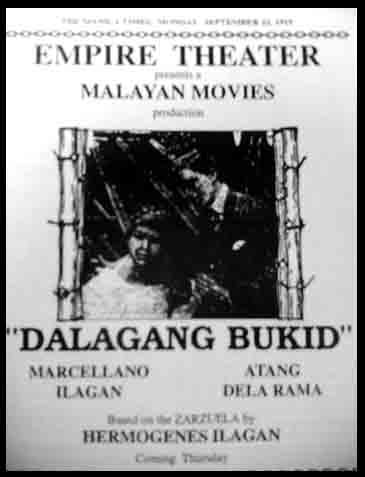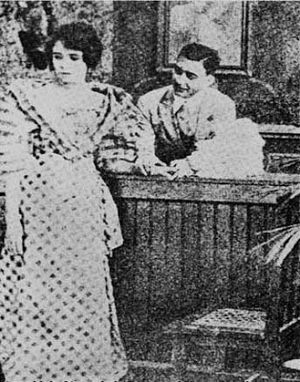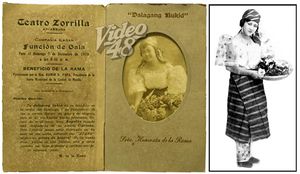Dalagang Bukid (lost Filipino silent film; 1919)
Dalagang Bukid (lit. Country Maiden)[1] is a 1919 Filipino silent film produced by Jose Nepocumeno. Released on September 12, 1919, and distributed by Malayan Movies, it is the first Filipino-produced film.
Based on the original zarzuela (a genre of Spanish comedy opera) made by Hermogenes Ilagan, a prominent zarzuela writer at that time and now known as the "Father of Tagalog Zarzuela." It starred the original cast of the zarzuela including Atang de la Rama, who in turn became the first Filipina film actress.
Plot
The plot follows the story of the original zarzuela. Angelita, a young flower vendor was forced by her parents to marry the rich Don Silvestre, a loan shark who got attracted by her beauty. However, Angelita had already fallen in love with a law student named Cipriano. Angelita's parents were against his love for Cipriano. Her parents were portrayed as lazy and consumed by gambling, thus explaining the shortage of money and explaining the reason for forcing Angelita to marry Don Silvestre.
Don Silvestre offered Angelita's parents a chance for her to win the beauty contest "La Vanguardia" in exchange for the marriage. Her parents accepted. Cipriano heard the plot and rushed to Angelita's house just in time to stop the ceremony. They go to the church instead where they marry. Angelita is still crowned as the winner of the beauty contest and Cipriano and Angelita announced they both are married. Hearing the news, Don Silvestre merely faints. This resulted in a sequel released in 1920, La Venganza de Don Silvestre (lit. The Vengeance of Don Silvestre.)[2]
In the original zarzuela meanwhile, Don Silvestre concedes to Cipriano.[3]
Production
In 1915, the Nepocumeno brothers Jose and Jesus established the Electro-Parnelio, a photography shop. Jose soon purchased his own film camera and was able to shoot the funeral of the first wife of Sergio Osmeña, Doña Estefania Veloso, in January 1918. Electro-Parnelio would soon grow into the first Filipino film company, Malayan Movies.[4]
On May 15th, 1917, Jose bought his first film equipment from Albert Yearsley and Edward Meyer Gross. He began his research and practiced using the film to produce the first local Filipino film. He decided to adapt Hermogenes Ilagan's zarzuela Dalagang Bukid, a box office hit at that time. He chose to use the original cast of the zarzuela which included Atang de la Rama and Marceliano Ilagan.[5]
Release
The film was released on September 12th, 1919. It was released with Filipino, English, and Spanish subtitles. It was said that during its theatrical run, the singing parts including the iconic "Nabasag ang Banga" had to be performed live by de la Rama and the violin, cornet, and piano players and had to repeat in every screening in Manila.[6]
Newspaper Manila Nueva wrote a review a day after the premiere:
"The home of Angelita, the pretty heroine, is a correct picture of many Philippine families, although it somehow exaggerates the negative tones."
Dalagang Bukid was considered a box success for earning ₱90,000 from a budget of only ₱25,000.
Availability
All of Nepocumeno's works have been deemed lost. As nitrate films were made of highly flammable materials, the studio of Malayan Movies is known to have been burnt down twice, in 1921 and in 1923. The battle of Manila is said to have destroyed remaining artifacts, including newsreels, equipment, and prints of early films.
Though in 2011, the Society of Filipino Archivists for Film (Sofia) got a lead that some scenes from the 1934 American movie Brides of Sulu were actually cut from Nepomuceno’s 1931 silent film, Moro Pirates. This discovery opened the possibility of other pre-war Filipino silent films in the archives of other countries, including Nepocumeno's works.[7]
References
- ↑ "East-West Film Journal" Retrieved 28 Oct '22
- ↑ Video48 Dalagang Bukid post. Retrieved 28 Oct '22
- ↑ The Story Behind the First Filipino Movie and Its Legacy Retrieved 28 Oct '22
- ↑ Tumblr Pelikula Uno Retrieved 28 Oct '22
- ↑ Jose Nepomuceno's "Dalagang Bukid" Retrieved 28 Oct '22
- ↑ Native Resistance: Philippine Cinema and Colonialism, 1898-1941 Retrieved 28 Oct '22
- ↑ Report: Archivists reclaim 2 silent PH films 'pirated' by US; film fest opens Friday Retrieved 28 Oct '22


